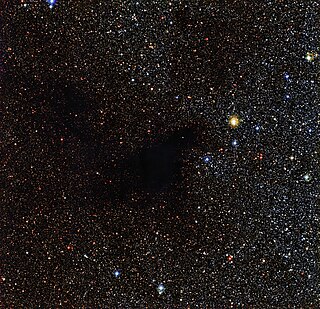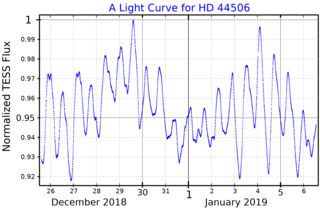
Apparent magnitude is a measure of the brightness of a star or other astronomical object to an observer on Earth. An object's apparent magnitude depends on its intrinsic luminosity, its distance, and any extinction of the object's light caused by interstellar dust along the line of sight to the observer.

Luminosity is an absolute measure of radiated electromagnetic energy (light) per unit time, and is synonymous with the radiant power emitted by a light-emitting object. In astronomy, luminosity is the total amount of electromagnetic energy emitted per unit of time by a star, galaxy, or other astronomical objects.

In astronomy, photometry, from Greek photo- ("light") and -metry ("measure"), is a technique used in astronomy that is concerned with measuring the flux or intensity of light radiated by astronomical objects. This light is measured through a telescope using a photometer, often made using electronic devices such as a CCD photometer or a photoelectric photometer that converts light into an electric current by the photoelectric effect. When calibrated against standard stars of known intensity and colour, photometers can measure the brightness or apparent magnitude of celestial objects.
Photometric-standard stars are a series of stars that have had their light output in various passbands of photometric system measured very carefully. Other objects can be observed using CCD cameras or photoelectric photometers connected to a telescope, and the flux, or amount of light received, can be compared to a photometric-standard star to determine the exact brightness, or stellar magnitude, of the object.

In astronomy, extinction is the absorption and scattering of electromagnetic radiation by dust and gas between an emitting astronomical object and the observer. Interstellar extinction was first documented as such in 1930 by Robert Julius Trumpler. However, its effects had been noted in 1847 by Friedrich Georg Wilhelm von Struve, and its effect on the colors of stars had been observed by a number of individuals who did not connect it with the general presence of galactic dust. For stars lying near the plane of the Milky Way which are within a few thousand parsecs of the Earth, extinction in the visual band of frequencies is roughly 1.8 magnitudes per kiloparsec.

In astronomy, magnitude is measure of the brightness of an object, usually in a defined passband. An imprecise but systematic determination of the magnitude of objects was introduced in ancient times by Hipparchus.

An asteroid spectral type is assigned to asteroids based on their reflectance spectrum, color, and sometimes albedo. These types are thought to correspond to an asteroid's surface composition. For small bodies that are not internally differentiated, the surface and internal compositions are presumably similar, while large bodies such as Ceres and Vesta are known to have internal structure. Over the years, there has been a number of surveys that resulted in a set of different taxonomic systems such as the Tholen, SMASS and Bus–DeMeo classifications.
Photographic magnitude is a measure of the relative brightness of a star or other astronomical object as imaged on a photographic film emulsion with a camera attached to a telescope. An object's apparent photographic magnitude depends on its intrinsic luminosity, its distance and any extinction of light by interstellar matter existing along the line of sight to the observer.

Psi1 Aurigae is a star in the northern constellation of Auriga. It is faintly visible to the naked eye with an apparent visual magnitude of 4.91. Based upon a measured annual parallax shift of 0.44 mas, it is approximately 7,500 light-years distant from the Earth. It is receding from the Sun with a radial velocity of +4.7 km/s.
In astronomy, a photometric system is a set of well-defined passbands, with a known sensitivity to incident radiation. The sensitivity usually depends on the optical system, detectors and filters used. For each photometric system a set of primary standard stars is provided.

The UBV photometric system, also called the Johnson system, is a photometric system usually employed for classifying stars according to their colors. It was the first standardized photometric system. The apparent magnitudes of stars in the system are often used to determine the color indices B−V and U−B, the difference between the B and V magnitudes and the U and B magnitudes respectively.
Vilnius photometric system is a medium-band seven-colour photometric system (UPXYZVS), created in 1963 by Vytautas Straižys and his coworkers. This system was highly optimized for classification of stars from ground-based observations. The system was chosen to be medium-band, to ensure the possibility to measure faint stars.
The Strömgren photometric system, abbreviated also as uvbyβ or simply uvby, and sometimes referred as Strömgren - Crawford photometric system, is a four-colour medium-passband photometric system plus Hβ (H-beta) filters for determining magnitudes and obtaining spectral classification of stars. Its use was pioneered by the Danish astronomer Bengt Strömgren in 1956 and was extended by his colleague the American astronomer David L. Crawford in 1958.
A color–color diagram is a means of comparing the colors of an astronomical object at different wavelengths. Astronomers typically observe at narrow bands around certain wavelengths, and objects observed will have different brightnesses in each band. The difference in brightness between two bands is referred to as color. On color–color diagrams, the color defined by two wavelength bands is plotted on the horizontal axis, and the color defined by another brightness difference will be plotted on the vertical axis.
In astronomy, the bolometric correction is the correction made to the absolute magnitude of an object in order to convert its visible magnitude to its bolometric magnitude. It is large for stars which radiate most of their energy outside of the visible range. A uniform scale for the correction has not yet been standardized.
(55638) 2002 VE95 (provisional designation 2002 VE95) is a trans-Neptunian object from the outermost region of the Solar System. It was discovered on 14 November 2002, by astronomers with the Near-Earth Asteroid Tracking program at the Palomar Observatory in California, United States. This resonant trans-Neptunian object is a member of the plutino population, locked in a 2:3 resonance with Neptune. The object is likely of primordial origin with a heterogeneous surface and a notably reddish color (RR) attributed to the presence of methanol and tholins. It has a poorly defined rotation period of 6.8 hours and measures approximately 250 kilometers (160 miles) in diameter, too small to be a dwarf planet candidate. As of 2021, it has not yet been named.
Pi Leonis, Latinised from π Leonis, is a single star in the zodiac constellation Leo. It is a red-hued star that is visible to the naked eye with an apparent visual magnitude of 4.70. This object is located at a distance of some 410 light-years from the Sun based on parallax, and is drifting further away with a radial velocity of +22 km/s. Because the star lies near the ecliptic it is subject to occultations by the Moon.
In astronomy, the zero point in a photometric system is defined as the magnitude of an object that produces 1 count per second on the detector. The zero point is used to calibrate a system to the standard magnitude system, as the flux detected from stars will vary from detector to detector. Traditionally, Vega is used as the calibration star for the zero point magnitude in specific pass bands, although often, an average of multiple stars is used for higher accuracy. It is not often practical to find Vega in the sky to calibrate the detector, so for general purposes, any star may be used in the sky that has a known apparent magnitude.

HD 44506 is a solitary, blue hued star located in the southern constellation Columba. The object is also called HR 2288, which is its Bright Star Catalog designation. It has an average apparent magnitude of 5.52, making it faintly visible to the naked eye under ideal conditions. HD 44506 is located relatively far at a distance of 1,800 light years based on Gaia DR3 parallax measurements but is receding with a heliocentric radial velocity of 54 km/s.










